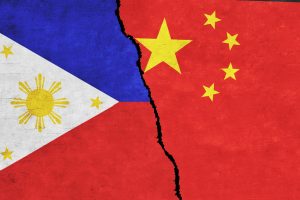The Philippine Coast Guard transported supplies Saturday to a naval garrison at a disputed shoal in the South China Sea without incident, the first time after reaching a “provisional arrangement” with China.
In a statement on Saturday, the Philippine Department of Foreign Affairs (DFA) said that the rotation and reprovisioning (RORE) mission to the Philippine garrison stationed at Second Thomas Shoal in the Spratly Islands, had been undertaken. It stated that “no untoward incidents were reported.”
The statement added that this was “the first RORE mission conducted under the ambit of the understanding” reached by the two sides on July 21, to allow the resupply of the Philippine personnel who live aboard the Sierra Madre, a Philippine Navy warship grounded on the shoal in 1999. Under this “provisional arrangement,” Manila and Beijing agreed to “manage differences through dialogue and consultation” and said “the agreement will not prejudice each other’s positions in the South China Sea.”
This came after a string of dangerous confrontations at Second Thomas Shoal, peaking with a major clash on June 17, in which the China Coast Guard (CCG) blocked a resupply mission to the Sierra Madre, injuring eight Filipino sailors, one seriously.
The Associated Press paraphrased a top Philippine security official as saying that the CCG and Philippine Coast Guard communicated ahead of Saturday’s mission, and their ships “did not issue two-way radio challenges like in the past to demand that each other’s ships leave the shoal immediately.” Also, for the first time at the shoal, CCG vessels did not shadow or attempt to block the Philippine vessels, as they have done repeatedly over the past two years, the official told the news agency.
While the underlying dispute remains unresolved, the successful RORE mission helps diffuse the tension that has grown at Second Thomas Shoal over the past two years. Still, the two sides remain in some disagreement over the details of the arrangement – a fact that bodes ill for the long-term resolution of the maritime and territorial disputes in the Spratly Islands.
After the mission on Saturday, a CCG spokesperson stated it had “supervised the operation throughout,” according to a report in the Global Times. The report also cited a Foreign Ministry spokesperson as saying that China was “notified of the resupply before it was carried out.”
“After confirming on-the-scene that the Philippine vessel carried only humanitarian living necessities, the Chinese side let the Philippine vessel through,” the Global Times paraphrased the Ministry spokesperson as saying.
For the second time in less than a week, the Philippines DFA was forced to issue a supplementary statement yesterday responding to the Chinese claim. It stated that the Chinese spokesperson has “mischaracterized the Philippines’ RORE mission.”
“Let us make it absolutely clear: the understanding between the Philippines and China was concluded in good faith, with the explicit agreement that it will not prejudice national positions,” the statement said. “It is not helpful to keep giving false notions about what has been agreed on and how they were implemented.”
The statement did not say exactly where the Chinese position was wrong, but in a similar exchange of statements last week, the Chinese Foreign Ministry stated that the CCG would permit the Philippines to “send living necessities” to the personnel aboard the Sierra Madre – but only if the Philippines “informs China in advance and after on-site verification is conducted.” It added that China would “monitor the entire resupply process.”
In a follow-up statement on July 22, the DFA said that the spokesperson’s comments “regarding prior notification and on-site notification,” which could be interpreted as an acknowledgment of Chinese sovereignty over the area, were “inaccurate” and diverged from what was agreed between the two sides.
Since the Philippines has not publicized the full terms of the provisional agreement, it is hard to know if the Chinese statements are correct, or whether it is shifting the goalposts of the agreement to its own benefit. If the former, it would perhaps be unsurprising that Manila would prefer to keep quiet on the details. If the latter, the agreement is unlikely to be any more than a short-term salve.
Not that Manila can rely on the Association of Southeast Asian Nations (ASEAN) to give voice to its concerns about recent Chinese actions in contested waters. The uneventful RORE mission to Second Thomas Shoal took place on the same day that foreign ministers and representatives from ASEAN member states concluded a week of meetings in Vientiane, during which the recent maritime tensions featured prominently. In the joint communique issued at the close of the meeting, the Southeast Asian bloc referenced the recent “serious incidents” in the South China Sea, but otherwise did little more than repeat its past calls for restraint. The bloc “reaffirmed the need to enhance mutual trust and confidence, exercise self-restraint … and avoid actions that may further complicate the situation.”
Sure enough, citing a senior Southeast Asian diplomat who was involved in closed-door negotiations, the Associated Press reported that the Philippines “pushed for the inclusion” of the June 17 collision in the joint communique but Cambodia and Laos, both of which are friendly to China, “opposed the wording.”

































